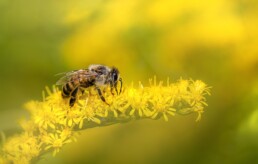European honeybee
Scientific name
Apis mellifera is the scientific name of the European honey bee.
Family
It belongs to the family Apidae, which includes other bees, such as solitary bees and some social bees.
Distribution and Habitat
European honey bees are common throughout Europe, but have also been introduced to other parts of the world, including North America, South America, Australia and New Zealand. They are adapted to a variety of habitats, but prefer areas with an abundant source of flowers for collecting nectar and pollen.
Behaviour
European honey bees are social bees that live in organised colonies. Each colony consists of a queen, workers and drones. Workers are sterile females that collect nectar and pollen, care for brood, and build and maintain the hive. Drones are males whose main function is reproduction. The queen is the only fertile female in the colony and lays eggs.
Feeding Habits
European honey bees feed mainly on nectar and pollen. They collect nectar from flowers to make honey and collect pollen as a source of protein. Pollen is also used to feed larvae in the hive.
Reproduction
Reproduction in European honey bee colonies is controlled by the queen. She lays fertilised eggs that will develop into workers and unfertilised eggs that will develop into drones. During the breeding season, the colony may produce new queens. When a new queen emerges, she may leave the hive in search of an existing colony or to form a new colony with a group of workers and drones.
Importantly, European honeybees play a crucial role in the pollination of plants, including many cultivated plants that are important for agriculture and food production.


